
myCBSEguide App
Download the app to get CBSE Sample Papers 2023-24, NCERT Solutions (Revised), Most Important Questions, Previous Year Question Bank, Mock Tests, and Detailed Notes.
Install NowCBSE Biology Chapter 15 Plant Growth and Development class 11 Notes Biology in PDF are available for free download in myCBSEguide mobile app. The best app for CBSE students now provides Plant Growth and Development class 11 Notes Biology latest chapter wise notes for quick preparation of CBSE board exams and school based annual examinations. Class 11 Biology notes on Chapter 15 Plant Growth and Development class 11 Notes Biology are also available for download in CBSE Guide website.
CBSE Guide Plant Growth and Development class 11 Notes
CBSE guide notes are the comprehensive notes which covers the latest syllabus of CBSE and NCERT. It includes all the topics given in NCERT class 11 Biology text book. Users can download CBSE guide quick revision notes from myCBSEguide mobile app and my CBSE guide website.
Plant Growth and Development class 11 Notes Biology
Download CBSE class 11th revision notes for Chapter 15 Plant Growth and Development class 11 Notes Biology in PDF format for free. Download revision notes for Plant Growth and Development class 11 Notes Biology and score high in exams. These are the Plant Growth and Development class 11 Notes Biology prepared by team of expert teachers. The revision notes help you revise the whole chapter in minutes. Revising notes in exam days is on of the best tips recommended by teachers during exam days.
Download Revision Notes as PDF
CBSE Quick Revision Notes
CBSE Class-11 Biology
CHAPTER-15
Plant Growth and Development class 11 Notes Biology
- Root, stem, leaves, flowers, fruits and seeds arise in orderly manner in plants. The sequence of growth is as follows-
- Plants complete their vegetative phase to move into reproductive phase in which flower and fruits are formed for continuation of life cycle of plant.
- Development is the sum of two processes growth and differentiation. Intrinsic and extrinsic factors control the process of growth and development in plants.
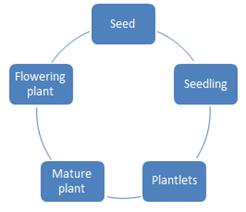
- Growth is a permanent or irreversible increase in dry weight, size, mass or volume of cell, organ or organism. It is internal or intrinsic in living beings.
- In plants growth is accomplished by cell division, increase in cell number and cell enlargement. So, growth is a quantitative phenomenon which can be measured in relation to time.
- Plant growth is generally indeterminate due to capacity of unlimited growth throughout the life. Meristem tissues are present at the certain locality of plant body.
- The plant growth in which new cells are always being added to plant body due to meristem is called open form of growth.
- Root apical meristem and shoot apical meristem are responsible for primary growth and elongation of plant body along the axis.
- Intercalary meristem located at nodes produce buds and new branches in plants.
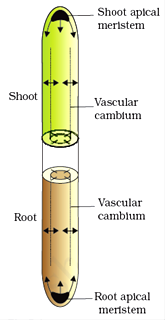
- Secondary growth in plants is the function of lateral meristem that is vascular cambium and cork cambium.
Growth is measurable
- At cellular level, growth is the increase in amount of protoplasm. It is difficult to measure the increase in amount of protoplasm but increase in cell, cell number and cell size can be measured.
- The parameter used to measure growth is increase in fresh weight, dry weight, length, area, and volume and cell number. All parameters are not used for every kind of growth.

- Formative phase is also called as the phase of cell formation or cell division. It occurs at root apex, shoot apex and other region having meristematic tissue. The rate of respiration is very high in the cells undergoing mitosis division in formative phase.
- Phase of Enlargement- newly formed cells produced in formative phase undergo enlargement. Enlarging cells also develops vacuoles that further increase the volume of cell.
- Cell enlargement occurs in all direction with maximum elongation in conducting tissues and fibres.
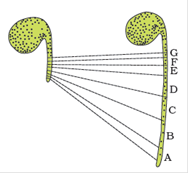
- Phase of maturation- the enlarged cells develops into special or particular type of cells by undergoing structural and physiological differentiation.
- Growth Rate- increase in growth per unit time is called growth rate. Growth rate may be arithmetic or geometrical.
- Arithmetic Growth- the rate of growth is constant and increase in growth occurs in arithmetic progression- 2,4,6,8 ……. It is found in root and shoot elongation.
Lt = L0 + rt
Length after time = length at beginning + growth rate x time.


- Geometric Growth- here initial growth is slow and increase rapidly thereafter. Every cell divides. The daughter cells grow and divide and the granddaughter cells that result into exponential growth.
- Geometrical growth is common in unicellular organisms when growing in nutrient rich medium.
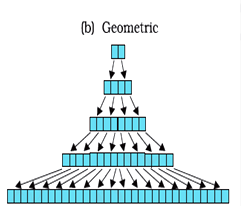
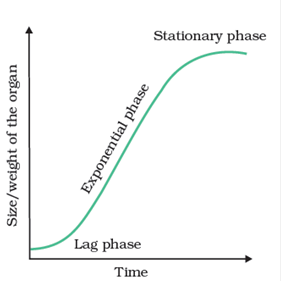
- Sigmoid growth curve consists of fast dividing exponential phase and stationary phase. It is typical of most living organisms in their natural environment.
Exponential growth can be represented as follows-
W1 =W0ert. W1 = final size, W0 = initial size, r = growth rate, t = time of growth and e is the base of natural logarithms (2.71828).
- Quantitative comparison between the growth of living system can be made by
- Measurement and comparison of total growth per unit time is called the absolute rate.
- The growth of given system per unit time expressed on a common basis is called relative growth rate.
Condition for growth
- Necessary condition for growth includes water, oxygen and essential elements. Water is required for cell enlargement and maintaining turgidity. Water also provide medium for enzymatic conditions.
- Protoplasm formation requires water and micro and macronutrients and act as source of energy.
- Optimal temperature and other environmental conditions are also essential for growth of the plant.
- Cells produced by apical meristem become specialized to perform specific function. This act of maturation is called differentiation.
- The living differentiated cells that have lost ability of division can regain the capacity of division. This phenomenon is called dedifferentiation. For example interfascicular cambium and cork cambium.
- Dedifferentiated cells mature and lose the capacity of cell division again to perform specific functions. This process is called redifferentiation.
Development
It is the sequence of events that occur in the life history of cell, organ or organism which includes seed germination, growth, differentiation, maturation, flowering, seed formation and senescence.
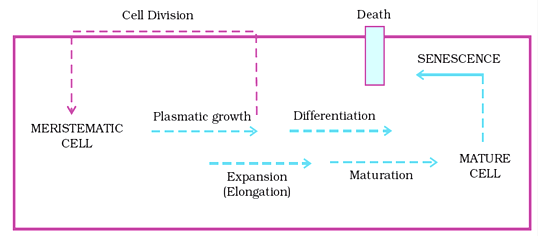
Sequence of development process in plant cell
- Different structures develop in different phases of growth as well as in response to environment. The ability to change under the influence of internal or external stimuli is called plasticity. Heterophylly in cotton plant is the example of plasticity.
Plant Growth Regulators are simple molecules of diverse chemical composition which may be indole compounds, adenine derivatives or derivatives of carotenoids.
- Auxin was isolated by F.W. Went from tips of coleoptiles of oat seedlings.
- The ‘bakane disease’ of rice seedlings is caused by fungal pathogen Gibberella fujikuroi. E. Kurosawa found that this disease is caused due to presence of Gibberellin.
- Skoog and Miller identified and crystallized the cytokinesis, promoting active substance called kinetin.
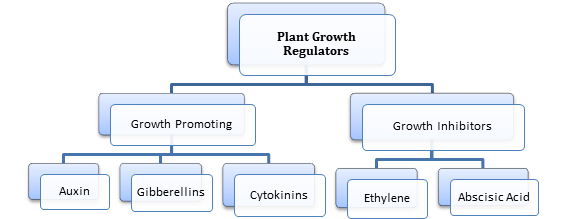
Auxin- was first isolated from human urine. It is commonly indole-3-acetic acid (IAA). It is generally produced at stem and root apex and migrate to site of action.
Functions-
- Cell enlargement.
- Apical dominance
- Cell division
- Inhibition of abscission
- Induce Parthenocarpy
Gibberellins- are promotery PGR found in more than 100 forms named as , , …. . The most common one is (Gibberellic Acid).
Functions-
- Cell elongation.
- Breaking of dormancy.
- Early maturity
- Seed germination.
Cytokinins- the plant growth hormone is basic in nature. Most common forms include kinetin, zeatin, etc. They are mainly synthesized in roots.
Functions-
- Cell division and cell differentiation.
- Essential for tissue culture.
- Overcome apical dominance.
- Promote nutrient mobilisation.
Ethylene – it is a gaseous hormone which stimulates transverse or isodiametric growth but retards the longitudinal one.
Functions–
- Inhibition of longitudinal growth.
- Fruit ripening
- Senescence
- Promote apical dominance
Abscisic Acid – it is also called stress hormone or dormin. It acts as a general plant growth inhibitor. Abscisic acid is produced in the roots of the plant and terminal buds at the top of plant.
Function-
- Bud dormancy
- Leaf senescence
- Induce Parthenocarpy
- Seed development and maturation.
Photoperiodism- the effect of photoperiods or day duration of light hours on the growth and development of plant, especially flowering is called Photoperiodism. On the basis of photoperiodic response, flowering plants have been divided into the following categories-
- Short Day Plants– they flower when photoperiod is below a critical period (continuous duration of light which must not be exceeded in short day plants and should always be exceeded in long day plants in order to bring them flower). Example- Xanthium, Rice, Sugarcane, Potato etc.
- Long Day Plants– these plants flower when they receive long photoperiod of light, greater than critical period. Example- Radish, Barley, Lettuce.
- Day Neutral Plants – the plant can blossom throughout the year. Example- Bean, Wild Kidney.
Vernalisation– is the process of shortening of the juvenile or vegetative phase and hastening of flowering by cold treatment. The stimulus of Vernalisation is perceived by meristematic cells.
- Vernalisation helps in shortening of vegetative period of plant and brings about early flowering.
- It is applicable to temperate plants like Wheat, Rice, Millets, etc.
Plant Growth and Development class 11 Notes
- CBSE Revision notes (PDF Download) Free
- CBSE Revision notes for Class 11 Biology PDF
- CBSE Revision notes Class 11 Biology – CBSE
- CBSE Revisions notes and Key Points Class 11 Biology
- Summary of the NCERT books all chapters in Biology class 11
- Short notes for CBSE class 11th Biology
- Key notes and chapter summary of Biology class 11
- Quick revision notes for CBSE board exams
CBSE Class-11 Revision Notes and Key Points
Plant Growth and Development class 11 Notes Biology. CBSE quick revision note for class-11 Mathematics, Physics, Chemistry, Biology and other subject are very helpful to revise the whole syllabus during exam days. The revision notes covers all important formulas and concepts given in the chapter. Even if you wish to have an overview of a chapter, quick revision notes are here to do if for you. These notes will certainly save your time during stressful exam days.
- Revision Notes for class-11 Physics
- Revision Notes for class-11 Chemistry
- Revision Notes for class-11 Mathematics
- Revision Notes for class-11 Biology
- Revision Notes for class-11 Accountancy
- Revision Notes for class-11 Economics
- Revision Notes for class-11 Business Studies
- Revision Notes for class-11 Computer Science
- Revision Notes for class-11 Informatics Practices
- Revision Notes for class-11 Geography
To download Plant Growth and Development class 11 Notes, sample paper for class 11 Chemistry, Physics, Biology, History, Political Science, Economics, Geography, Computer Science, Home Science, Accountancy, Business Studies and Home Science; do check myCBSEguide app or website. myCBSEguide provides sample papers with solution, test papers for chapter-wise practice, NCERT solutions, NCERT Exemplar solutions, quick revision notes for ready reference, CBSE guess papers and CBSE important question papers. Sample Paper all are made available through the best app for CBSE students and myCBSEguide website.
- The Living World class 11 Notes Biology
- Biological Classification class 11 Notes Biology
- Plant Kingdom class 11 Notes Biology
- Animal Kingdom class 11 Notes Biology
- Morphology of Flowering Plants class 11 Notes Biology
- Anatomy of Flowering Plants class 11 Notes Biology
- Structural Organisation in Animals class 11 Notes Biology
- Cell Structure and Functions class 11 Notes Biology
- Biomolecules class 11 Notes Biology
- Cell Cycle and Cell Division class 11 Notes Biology
- Transport in Plants class 11 Notes Biology
- Mineral Nutrition class 11 Notes Biology
- Photosynthesis in higher plants class 11 Notes Biology
- Respiration in Plants class 11 Notes Biology
- Plant Growth and Development class 11 Notes Biology
- Digestion And Absorption class 11 Notes Biology
- Breathing and Exchange of Gases class 11 Notes Biology
- Body Fluids And Circulation class 11 Notes Biology
- Excretory Products and their Elimination class 11 Notes Biology
- Locomotion and Movement class 11 Notes Biology
- Neural Control and Coordination class 11 Notes Biology
- Chemical Coordination and Integration class 11 Notes Biology
- Cell Structure and Functions class 11 Notes Biology

Test Generator
Create question paper PDF and online tests with your own name & logo in minutes.
Create Now
myCBSEguide
Question Bank, Mock Tests, Exam Papers, NCERT Solutions, Sample Papers, Notes
Install Now
?Jai shree RAM??
?Jai shree RAM??